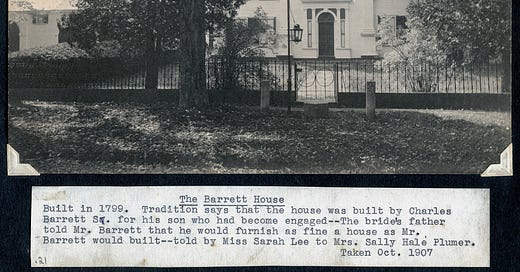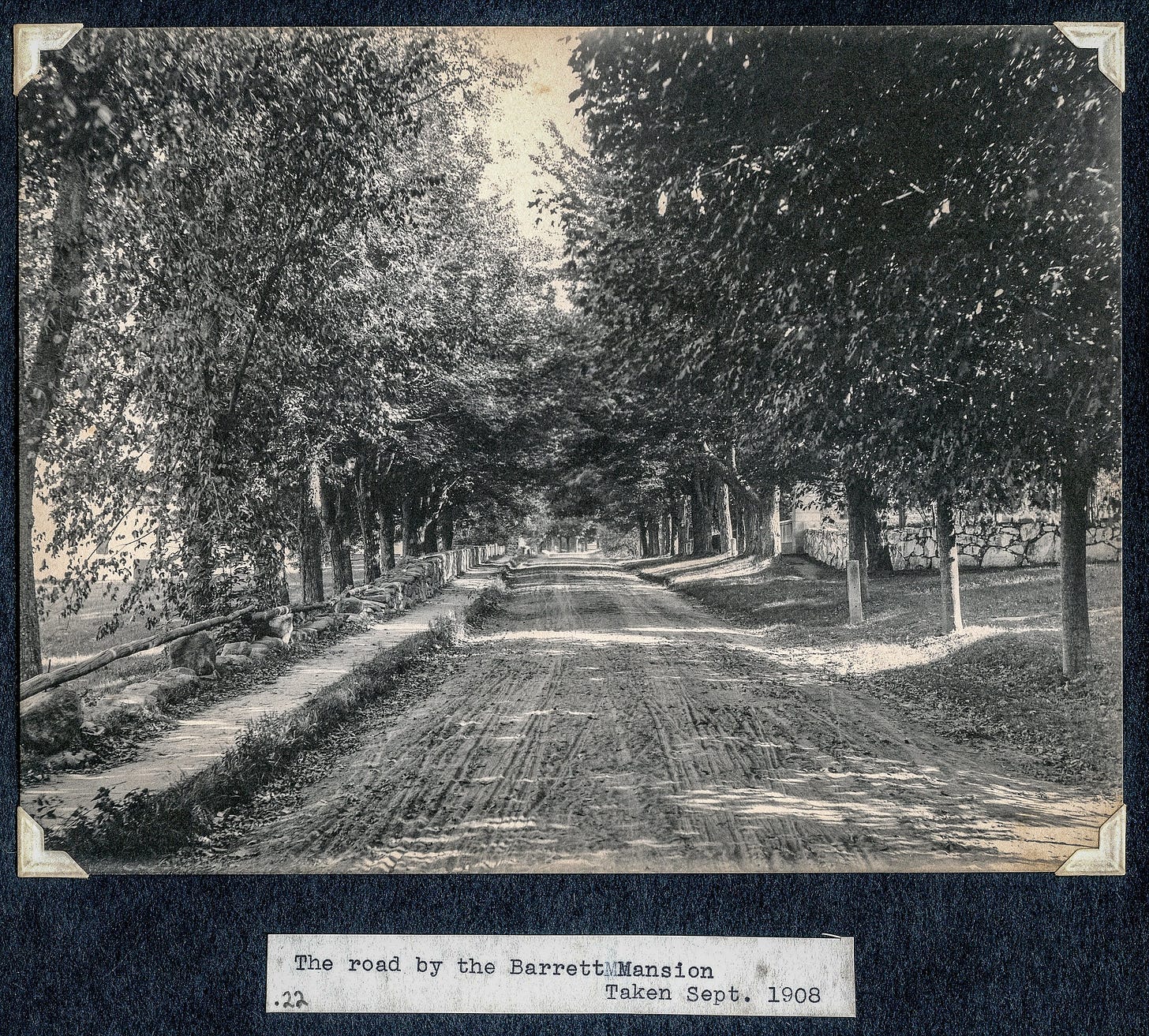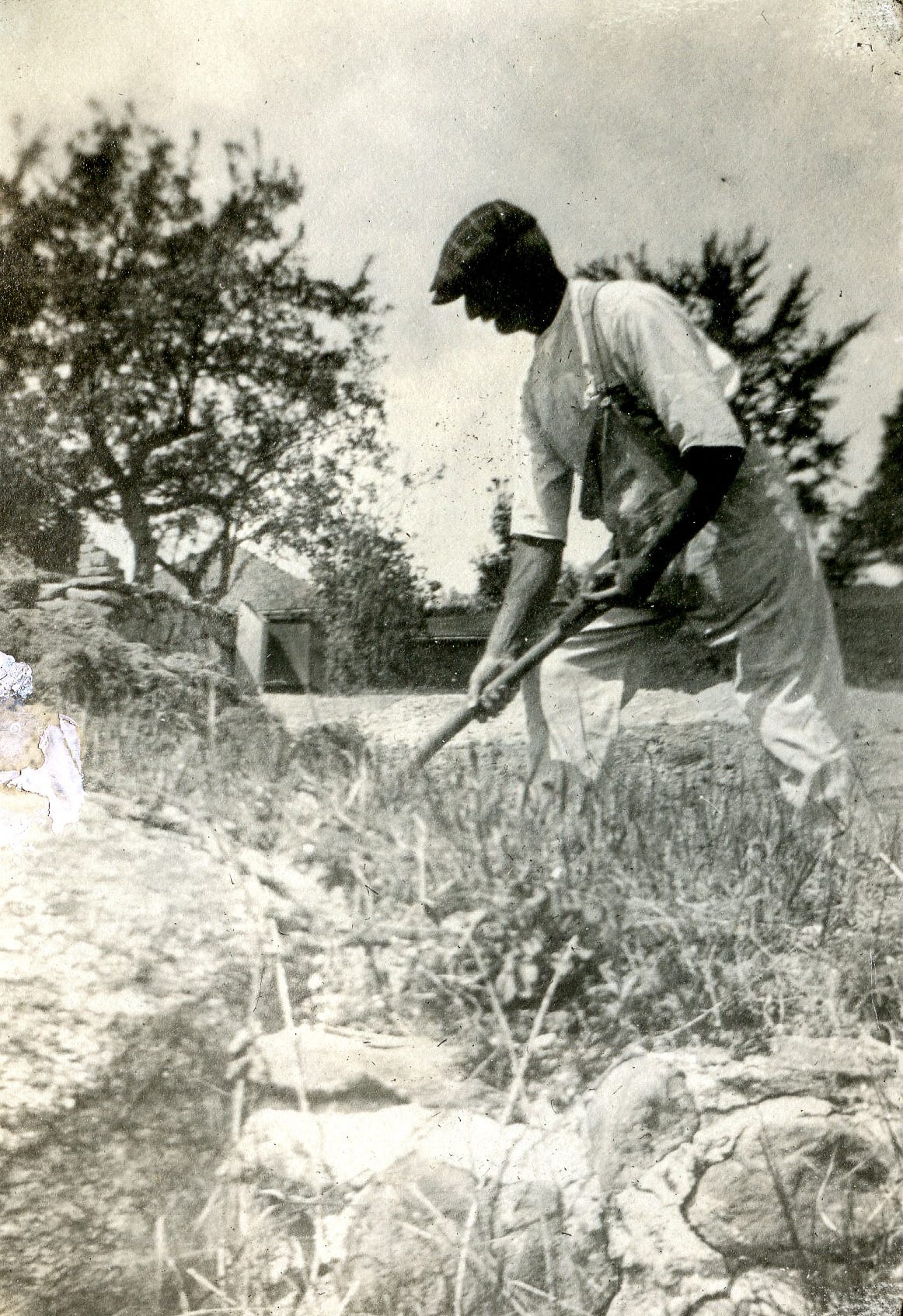From an album of photos taken by Charles A. Plumer. Presented to the New Ipswich Historical Society by Mrs. Melinda R. Kendrew in 1961. The album was compiled by Hazel E. Balch. I wish that lantern still existed.
Barrett House
Main Street (in front of Barrett House)
A tree lined road with a sidewalk.
The People of New Ipswich
The New Ipswich Historical Society has a large collection of “people” photographs. There are group photos, formal studio portraits and what might be considered snapshots of the day. We’ll feature one or more in this newsletter. Not everyone has been identified, so we appreciate reader input.
On this day - May 2, 1908
James Roger diary entry
May 2nd (Saturday)
Slight frost Wind west to south. David teaming for Walker. A good turnout at dance last night. A good many Frenchies. Some of them noisy. Wright and Parker’s horses in our barn. David went for grain in afternoon. Rain at night. Got P.C. and flowers from Hamish & letter from Alice.
On this day - May 2, 1897
William Jurian Kaula diary - Oh howling Dinet!
2 May 1897
I have got weary of both Salons now and do not draw any comparisons between them. I should not fail to recall some of the best examples here besides those that I mentioned on the 29 of April. Munier paints a beautiful landscape with figures with a fine feeling for color besides a highly-finished technique with faultless drawing. How many painters can approach him with all their tricks and novel schemes? His best work has been purchased by the State - a twilight landscape with the yellow sky reflecting in a pool. There are two figures, one is kneeling and reaching out into the pond with a dipper. The whole is enveloped in a soft and delicate atmosphere that is simply delicious.
Munier's smaller canvases have a tendency toward being photographic in finish yet full of feeling for actual nature...Cazin may have the reputation of being the landscape painter of the New Salon and I saw none at the Old Salon who could compete with him. Much that I just wrote of Munier would apply to Cazin in his landscapes - Cazin often introduces figures but only on a small scale and secondary to the scene. Cazin may often be the same but never monotonous. He has a very acute observation for the subtle effects in nature and is fond of painting twilights and often attempting moonlights and never attempts any circus effects of sky and water and his attention is only devoted to the things that he knows so well.
Fitz Tharlow is not a Frenchman but a Swede. As a painter of running water he has no rival. He delights in the turbulent mill-stream with the whirling of the eddies under a soft evening sky or the moonlight. His works and reputation will live -
Most of the boys go crazy over Frank Branwyn who handles his paint with the most amazing cleverness. The whole painting has somewhat the appearance of a tapestry. It is strong and rich in color and very harmonious yet has not the effect of nature. It is an attractive work in spite of the lack of values and truth for its decorative qualities and artistic execution.
Oh howling Dinet! He belongs to that set that style themselves the "Orientalists" and most of them are tame in comparison with him. Dinet has a blood-thirsty taste now and then for something horrible and two of his canvases are enough to make the hair stand on end. There is no excuse for depicting such scenes which are so brutal. But the scene inside of a Harem is a gem, a glorious combination of color of a female figure whose brilliant garments are flooded with sunlight. Around her groups a number of men in Eastern costumes wo are lying in a confused mass around her feet while she cooly blows cigarette smoke into the air. I have seen this picture before at Durand Ruel's where I journeyed several times to see it and even enquire at the price of the work which was equal to $800. It would have been a splendid investment for a picture-buyer as Dinet is a coming man. The picture has now been bought by the State.
One needs blue glasses in almost every room where the Impressionists illuminate the atmosphere. Will time prove these men insane? If so the speedy arrival of that time will greatly benefit the public. Some of them are fairly intelligible but so many paint "impressions" without much nature and the mystery of their problems are only understood by the perpetrator.
Now comes that class of men who are not actual impressionists but yet startle the public with those things in nature that have been little to unknown in paint. I was startled in one room on beholding a sun shining through the trees that seemed as luminous as an electric light. There were three canvases of the same kind of effect that had so much realism in them that the light almost seemed to dazzke the eyes. Any person who looks at the sun which is shining brightly will see colored disks in everything they look at for several moments after and so this painter has covered one canvas with these colored disks which are spotted in the trees and foreground and all around the painted sun with its fountain of streaks of light that blossom out like a majestic wheel...Alexander Harrison has two marines or shore scenes that would puzzle a native of any country. Each one would say that they were effects of nature that existed in a locality that was unknown to them. Where did he paint them? One marine with a vile green water that tossed up foam the color of corn-meal, and the other a crimson sky with a scarlet pond that reflected some trees of the feather-duster type. The French critics were at loss to comprehend these works and naturally imagines that they might be common in America. They might be seen by a man with delirium tremors...
Boldini's portraits are almost black and white and a great disappointment as I had received my ideas of his ability from seeing reproductions in America.
Prinet, one of my instructors, is dull and heavy and his work in no way seems to approach the quality of "The Bath" which is in the Luxumburg Gallery.
Childe Hassam shows his small canvas of the young lady on the rock which won a $1,000 prize last winter at the Boston Art Club. The hanging committee at the Salon thought that a place up near the ceiling was good enough for it.
Among the "boys" represented at this Salon are Cline, Marsh, and Lyendecker. [There are two Lyendecker brothers, who have the reputation of being the strongest American students in Paris - as if it were easy to determine - nevertheless they sweep everything before them in the schools and carry away more prizes than any other Americans there.] "Everybody paints these days," said the critic in the "Figaro." "And soon it will be a mark of distinction not to 'exhibit' at the Salon."
(Diary footnote: The amount of students' work in both Salons is enormous and the mere fact of a picture being "exhibited at the Salon" does not mean what the majority of young artists imagine. Many of the same works would not gain admittance to many of the annual exhibitions in America - particularly to the best of them - the Society of American Artists in New York. Those that think they are made after exposing at the Salons will discover a mistake when they return to the States especially if they intend to settle in some of the large eastern cities like Boston, New York, or Philadelphia. A great deal of this sham about the Salons being a criterion of merit has been exploded time and time again in the newspapers.






Thanks for the photos of old New Ipswich. Those maple trees were larger when we moved to town in 1958, and sadly those on the downhill side starting to die from the effects of road salt runoff. We lived next door to the Barrett mansion but as children didn't know that we are distantly related to the Charles Barrett family. I used to play with Butch Burseil, son of the resident caretakers, and he showed me the secret tunnel leading from the barn into their wing of the house.